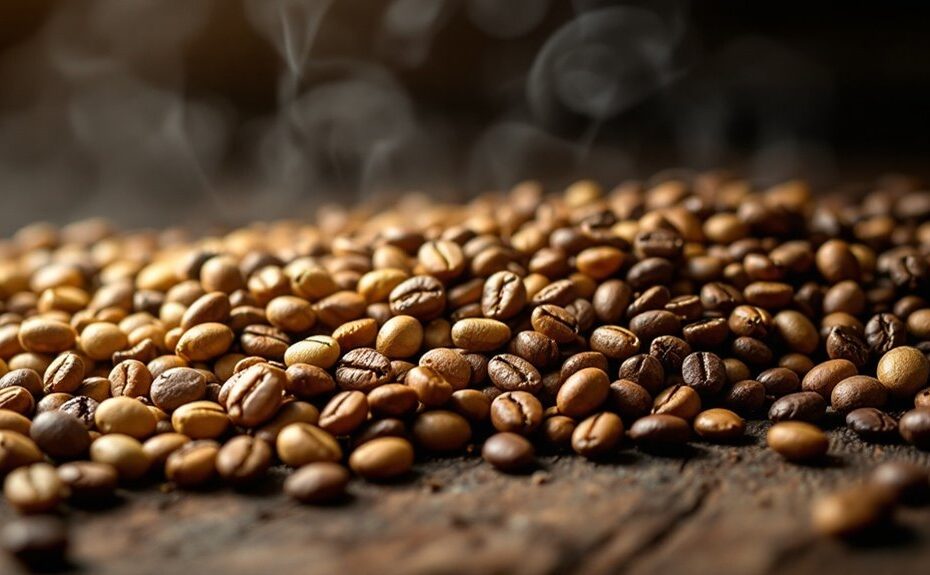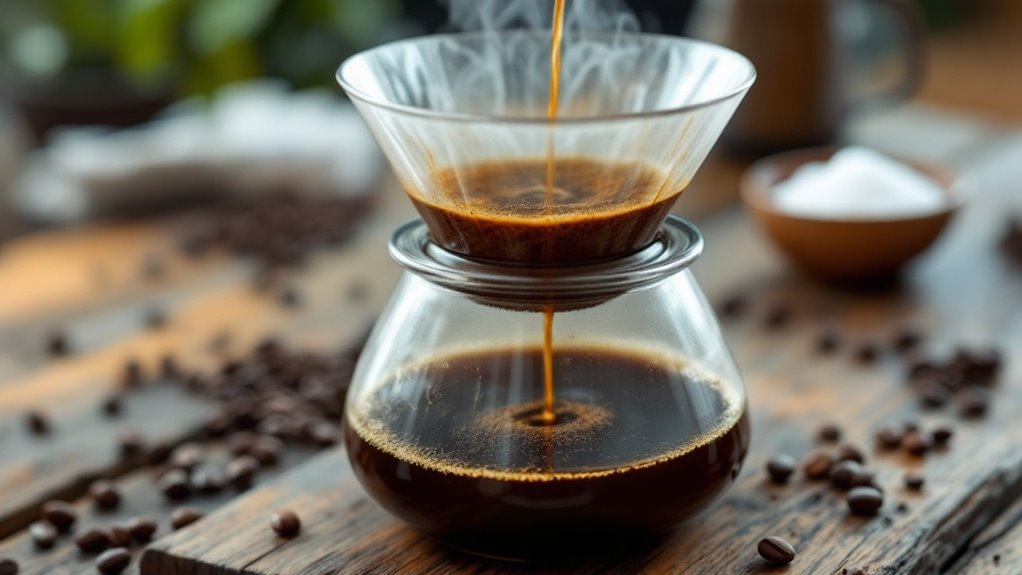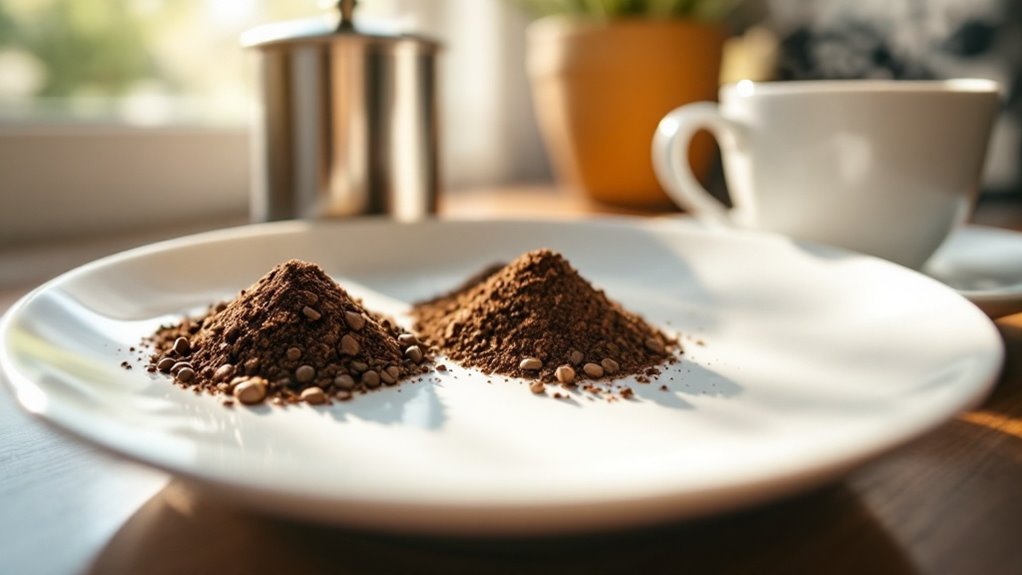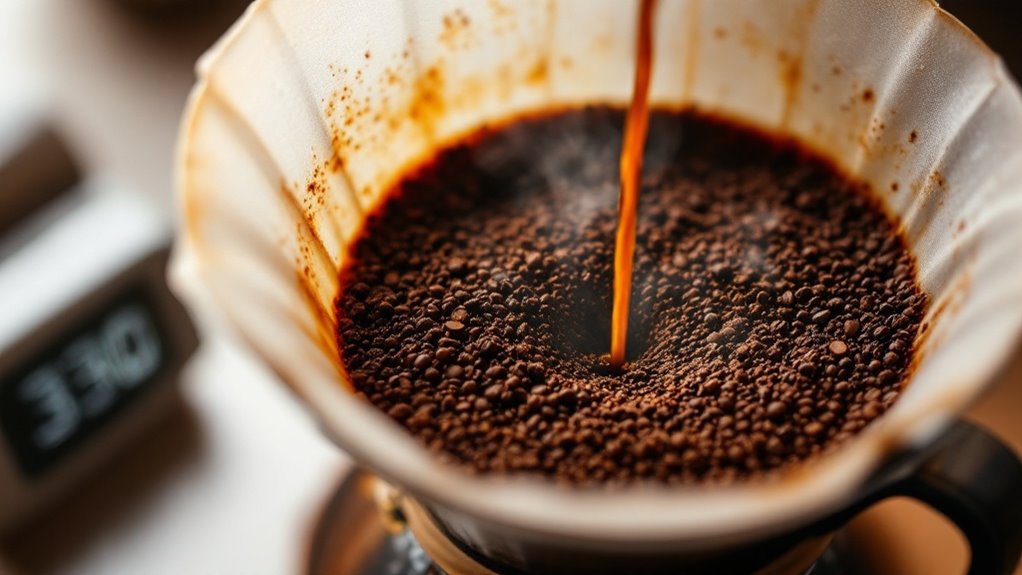







The flavor of your coffee hinges on a delicate dance of heat and time during roasting. As the beans heat up, chemical reactions like the Maillard process and caramelization release a spectrum of flavors—from bright, fruity notes to deep, smoky richness. But here's the catch: the roast level you choose can dramatically shift the balance of acidity, sweetness, and body. Light roasts preserve the bean's origin characteristics, while dark roasts lean into bold, intense profiles. How do you decide which roast suits your palate? The answer lies in understanding the science behind the roast.
Key Takeaways
- Roasting triggers the Maillard reaction and caramelization, creating fruity, floral, and sweet flavors in coffee.
- Light roasts (350º–410º) preserve bright acidity and fruity notes, while dark roasts (above 440º) emphasize bold, smoky flavors.
- The first crack at 400ºF marks bean expansion, light brown color, and bright, acidic flavor development.
- Pyrolysis near 430ºF smooths acidity, deepens body, and enhances richness, balancing sweetness and complexity.
- Over-roasting beyond 465ºF risks bitterness and loss of nuanced flavors, diminishing the coffee's overall quality.
The Science Behind Coffee Roasting
Roasting coffee transforms raw, green beans into the aromatic, flavorful product we recognize and cherish through a series of complex chemical reactions. During the roasting process, green coffee beans undergo significant physical and chemical changes as they're exposed to increasing temperatures. Between 300-400°F, the Maillard reaction kicks in, breaking down proteins and sugars to create hundreds of flavor compounds, ranging from fruity and floral to chocolatey notes. Around 370°F, caramelization begins, converting sucrose into deeper, honey-like sweetness. As the roast progresses, you'll hear the first crack, a popping sound signaling the beans have reached just above 400°F. At this stage, the beans expand, lose about 5% of their weight, and develop a light brown color with bright, acidic flavor profiles. Beyond this, pyrolysis occurs near 430°F, expelling carbon dioxide, darkening the beans, and smoothing acidic tones for a richer, more balanced taste. The second crack, just before 450°F, marks the shift to darker roasts, introducing woody, carbon-like flavors. However, over-roasting risks bitterness and loss of complexity, so the degree of roast must be carefully controlled to achieve the desired flavor profiles.
Key Chemical Reactions in Roasting
As temperatures rise between 300-400°F, the Maillard reaction takes center stage, breaking down proteins and sugars in green coffee beans to produce a symphony of flavor compounds. This chemical reaction generates fruity, floral, and nutty aromas, laying the foundation for the coffee's complexity. Around 370°F, caramelization begins, converting sucrose into deeper, honey-like sweetness and darker flavors, adding richness to the profile. As roasting progresses, you'll hear the first crack just above 400°F, signaling the beans' expansion and a 5% weight loss. This stage develops light brown color, enhances acidity, and introduces bright, lively notes. Near 430°F, pyrolysis occurs, expelling carbon dioxide and darkening the beans further. This process smooths out acidity, intensifies body, and deepens the flavor profile. Finally, the second crack, just before 450°F, produces woody, carbon-y flavors typical of dark roasts. However, over-roasting risks bitterness, as the chemical reactions push the beans toward charred, overly smoky tones. Each stage of roasting—Maillard reaction, caramelization, first crack, pyrolysis, and second crack—shapes the coffee's acidity, aroma, and overall flavor compounds, creating a dynamic interplay of chemical reactions that define your cup.
How Roast Levels Shape Flavor Profiles
The journey from green coffee beans to your cup hinges on the roast level, a critical factor that dictates the flavor profile. Light roasts, roasted at 350º–410º, preserve the bean's inherent characteristics, yielding a bright, acidic taste with pronounced fruity and floral notes. These roasted beans retain higher caffeine levels and showcase the coffee's origin, making them ideal for those who appreciate nuanced flavors. Medium roasts, roasted at 410º–440º, strike a balance between acidity, sweetness, and body. They develop a richer aroma and a more rounded flavor, often described as caramel-like or nutty, while still hinting at the bean's origin. Dark roasts, roasted above 440º, emphasize bold, smoky flavors with reduced acidity and caffeine. The extended roasting process masks the bean's original varietal character, creating a robust, full-bodied coffee flavor. However, over-roasting beyond 465º risks a charcoal-like taste, stripping the coffee of its complexity and leaving only bitterness. Each roast level shapes the interplay of sweetness, body, acidity, and aroma, offering distinct experiences tailored to your taste preferences.
Roasting Techniques and Their Impact
Beyond the roast level, the method used to roast coffee beans plays a significant role in shaping their final flavor. Roasting techniques determine how heat is applied, influencing the roast profile and the development of flavor and aroma. Drum roasters, for example, use a rotating chamber to evenly roast the coffee, guaranteeing consistent heat distribution as the beans turn from green to brown. This method helps preserve delicate origin-specific notes in lighter coffee roasts, while allowing you to roast darker for bolder, smokier profiles. The timing and intensity of heat application are critical; too much heat too quickly can scorch the beans, while insufficient heat may underdevelop their flavors. As the green beans roast, they undergo chemical changes that release oils and sugars, creating the complexity of the final cup. Precision in roasting techniques guarantees that the beans reach their ideal roast level without over-roasting, which can lead to a charcoal-like taste. By mastering these methods, you can highlight the unique characteristics of each bean, balancing acidity, sweetness, and body to craft a tailored flavor experience.
Choosing the Right Roast for Your Taste
When selecting a coffee roast, it's essential to evaluate how roast levels affect flavor, body, and acidity to align with your personal taste preferences. Light roasts, roasted between 350º–410º, highlight bright, acidic, and fruity notes, making them ideal if you enjoy a vibrant coffee taste with higher caffeine content. Medium roasts, roasted from 410º–440º, strike a balance with moderate acidity, sweetness, and body, offering a versatile taste profile that suits most brewing methods. Dark roasts, roasted above 440º, deliver bold, smoky, and chocolatey flavors with reduced acidity and lower caffeine content, appealing to those who prefer a richer, more intense coffee experience. Your brewing method also plays a role; light roasts shine in pour-over or drip methods, while dark roasts excel in espresso or French press. Consider your taste preferences for acidity and flavor intensity, as well as how the roast complements your chosen brewing method. By understanding these factors, you can select a roast that enhances your coffee taste and aligns with your desired caffeine content.
Disclosure: As an Amazon Associate, I earn from qualifying purchases.




